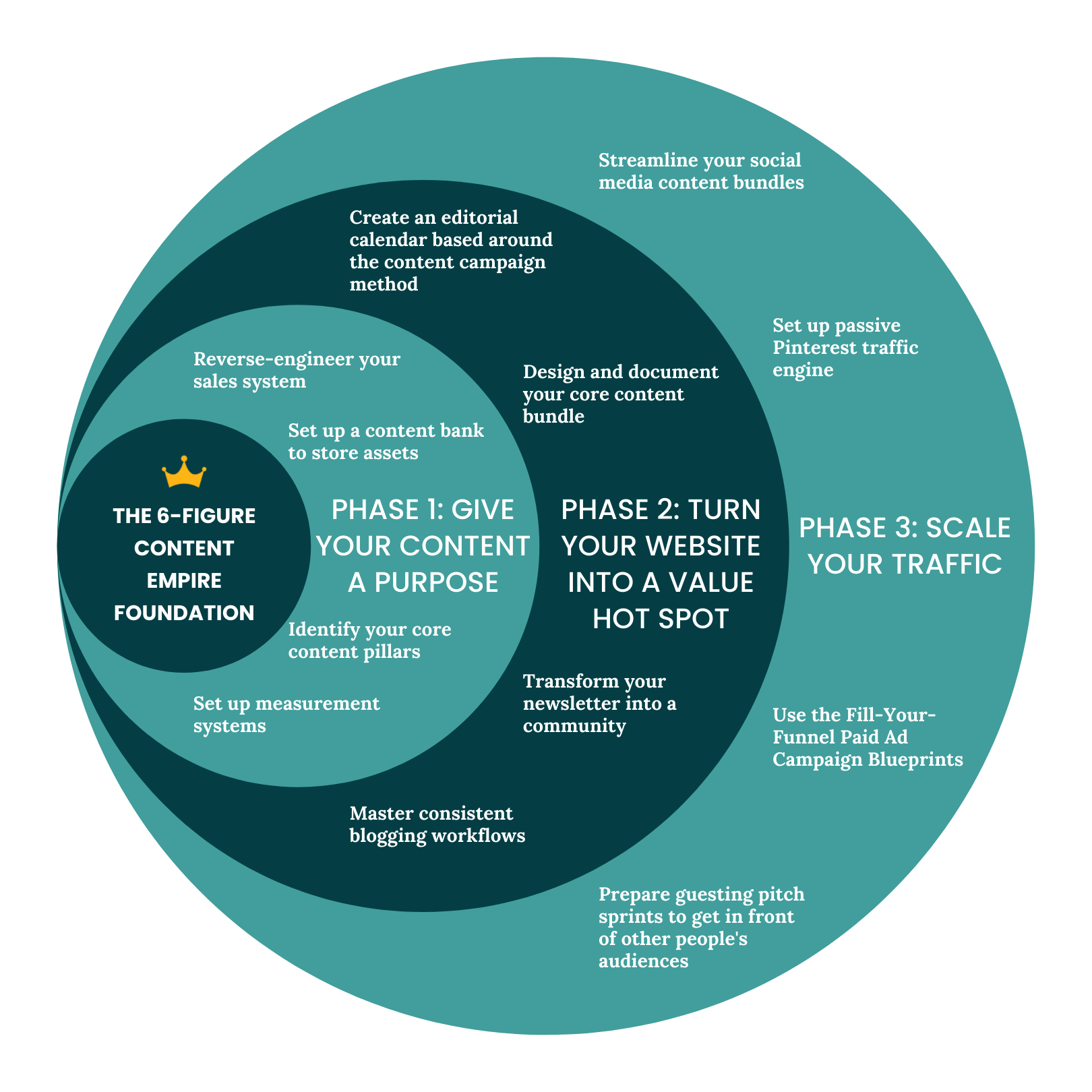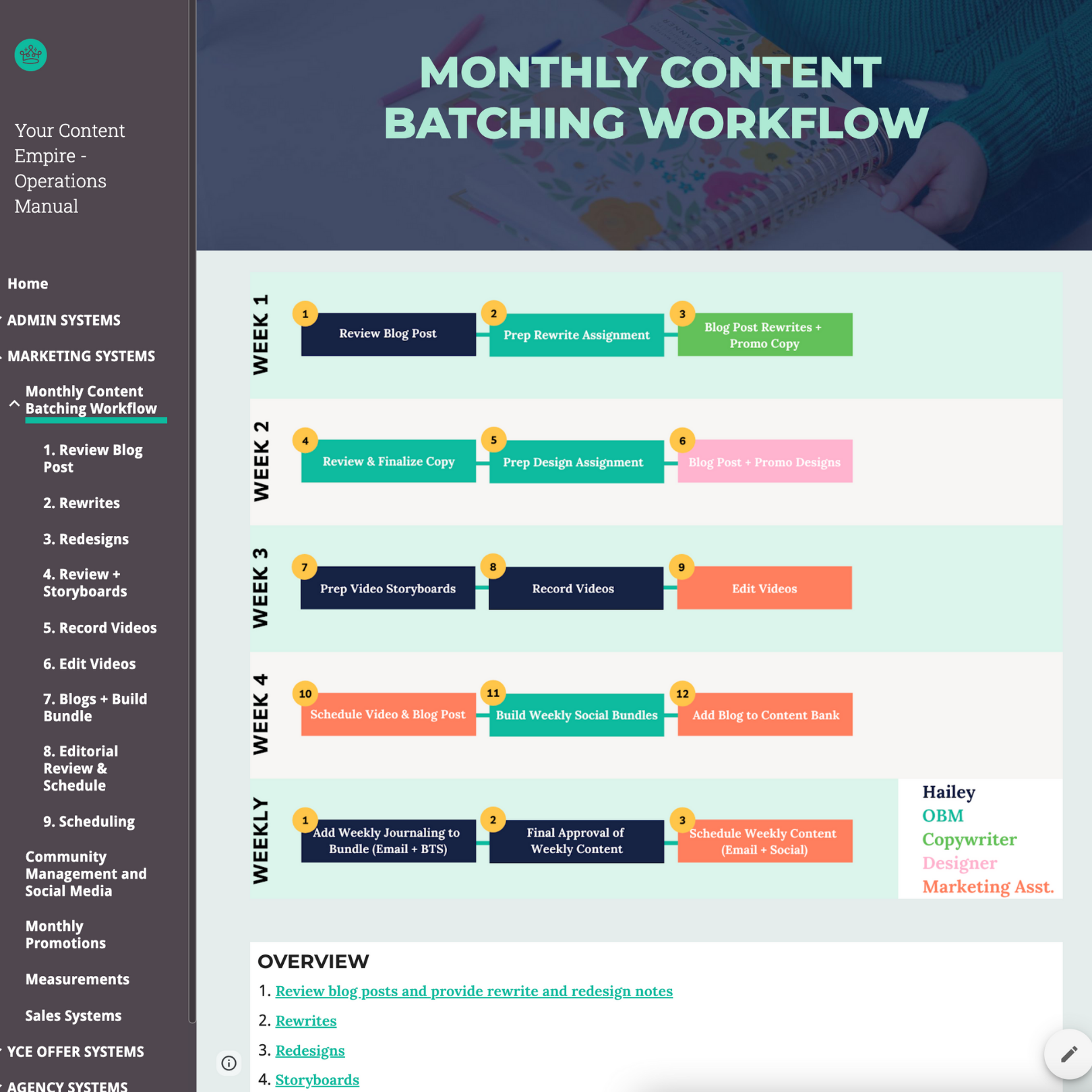Should running a profitable business steal away every second of your day? Running 6-figure businesses can take full commitment, but it doesn’t need to take full-time hours. It’s a commonly believed myth that you need to work 60-hour weeks to run a 6-figure and beyond business—but this simply isn’t true.
How do I know this with certainty? Because I've done it. In fact, I actually run 2 x 6-figure businesses in less than 20 hours a week on average and am in the middle of starting another.
Prefer to watch instead?
But this hasn’t always been the case. Figuring out how to run my business this way was a direct result of way too many late nights with not a day off in sight. I had burnout and experienced a real dark night-of-the-soul moment when I knew I couldn't continue working the way I did.
With that being said, I also recognize how the time and energy I invested in the early years set me up for success. Without it, I doubt I’d have the businesses I do now. And I have a lot of gratitude and respect for younger me who paid that price.
There was a time I thought I’d always be glued to my desk and destined to abandon any semblance of a social life forever—but luckily that’s not the case and there were 8 levers I’ve found that allow me do more in less time and focus on the things that matter.
In this post, I’m sharing what those levers are and how you can use them to increase the profitability of your business with a whole lot less sweat equity required.
But just before we get started: a small disclaimer. I am a woman of privilege. I’m a white woman, without kids, living in a dual-income household. I acknowledge not everyone reading this will have the same privilege as me. Perhaps all of the strategies outlined here won’t work for you, but I encourage you to take what does and leave what doesn’t fit. That considered anything that you can implement that has the power to help you run your business even better and give you more freedom is worth the effort.
Now, let’s address the critical aspect of mindset before we get to the eight levers that help me grow and run six-figure businesses in 20 hours a week or less.
Hustle and Anti-Hustle Culture: Where's the Middle Ground?
There’s been a big reaction against hustle culture in recent years, and rightfully so. Hustle culture is harmful to entrepreneurs and small business owners. It made us believe we were only worthy if we never stopped working, felt exhausted, disregarded much-needed breaks, and completely neglected our mental health.
But then on the other side, there’s the anti-hustle culture response, which has been both confronting and confusing for small business owners and entrepreneurs. Anti-hustle culture says if we’re working hard, we’re doing it wrong. It tells us every day should come with the utmost leisure and flexibility—but running a business can’t always be that way.
This is why I take issue with both hustle culture and anti-hustle culture: both are unrealistic and inauthentic. They’ve left no room for the people in the middle ground who understand that running a business is going to have some give and take.
Building a business is hard work, especially in the initial stages—it’s irresponsible to try to perpetuate the myth that it isn’t. You're not a bad business owner if you can't do everything you need to do in 20 hours a week or less. Think of this as a goal you can aspire to and work towards because it is possible for every business owner—but timing is everything.
For myself, here are the 8 levers that make it possible:
Lever #1: A Signature Process
One of the biggest time-saving and value-adding assets in a service-based or information-based business is a signature process. Your signature process is unique to you and it’s a proven framework that you guide someone through the deliver on the promise of your offer (aka the results).
I have 2 signature processes: In the agency, there’s my 3-layer profitable funnel-building methodology and in my education company, there’s the content empire blueprint.
Here’s a peek at the Your Content Empire framework that guides my courses, programs and content:
 These save me oodles of time because it means that I’m not reinventing the wheel for every single client or customer who works with me. It builds trust because I have tons of proof of the signature processes working with hundreds of businesses across multiple industries and niches.
These save me oodles of time because it means that I’m not reinventing the wheel for every single client or customer who works with me. It builds trust because I have tons of proof of the signature processes working with hundreds of businesses across multiple industries and niches.
There are 2 important things to keep in mind when it comes a signature process through:
#1 – It’s a tool to guide your client’s or customer’s journey not to restrict it – even though I have a pretty set process I follow with every single client, I do customize it for every single client depending on their business and goals. The signature process in a service-based business is usually a starting place, not a copy-and-paste template.
#2 – Because a signature process relies on proof that it works, it isn’t something you should have figured out right away in your business. Your first year (or couple of years) will likely be experimenting with different versions of a process until you find something that works for you and the people you want to help.
Lever #2: Investment in Long-Term Content Assets
Investing in long-term content assets completely changed the way I run my business. Zooming out and seeing the bigger picture of my body of work made me realize that creating content in a last-minute panic was never going to get me where I wanted to be.
One of my favourite strategies is building a capsule content collection, which includes creating 12 core blog posts around an offer, based on specific topics. I create capsule content for both of my businesses. Doing this got me out of the weeds when it comes to creating content because it helps me step off the hamster wheel knowing the assets I need have already been created to be pulled and published whenever I need them.
Capsule content allows you to stay consistent. However, it doesn’t mean you can’t create new content when the mood strikes (I still create content pretty regularly). You can still whip up new content when you feel inspired, but you won’t be under the same pressure to create something or don’t show up.
Lever #3: Systems
Besides my body of work (my content assets + signature process my offers are based around), my next most valuable asset is my systems. But where do you start? Think about anything you do more than once in your business—whether that’s daily, weekly, monthly, or quarterly—and ask yourself if you can turn it into a system.
A great example is with emails. If you find yourself writing a very similar email regularly, for example to follow up with a client, this would be the perfect opportunity to create a canned email template so you can save time on every single one of these interactions rather than starting from scratch all the time.
Here’s a peek at my operations manual:

Here are the categories I use to brainstorm the systems I need in my business:
- Offer systems
- Content systems
- CEO systems
- Marketing systems
- Administrative systems
If you’re not sure where to start with systems, I find that documenting your offer delivery process and content workflow tends to have the biggest bang for your buck when it comes to saving you time.
Lever #4: Team
Once you have your systems and the signature process in place, hiring AND delegating becomes much much easier. And if you can hire someone to do the things you don’t want to do or don’t need to do, you’ll free up valuable time to spend elsewhere.
When you pair you’ve documented the systems for the things you want to hire someone else to do, you’ll barely have to spend time training and you won’t as vulnerable to team turnover because if a team member leaves, you won’t be facing hours and hours of training and onboarding.
But keep this in mind: Some of the biggest mistakes you can make in your business revolve around your team, including:
- Hiring too soon. Hiring people for your business can be seen as a status symbol for solopreneurs, which is why so many business owners feel the pressure to start building a team before they’re actually ready. Just because you hire more people in your business doesn’t mean you’re thriving more than the next person who hasn’t yet. Wait until you’re ready – meaning you have your systems for whatever they’ll be doing documented and have room in your sales to pay someone.
- Hiring the wrong people. Before you go looking for your first or next team member ask yourself where you really need support. Your next hire should be able to fill those specific gaps with their particular skills. I always recommend doing a test assignment (paid!) and a trial period in the hiring process to give you both a chance to determine if the role is a right fit.
- Not seeing yourself as a coach. Great teams aren’t built overnight, and no matter how skilled your hire is they will still need time to adapt to your processes and systems. When you start bringing people on board, your job goes beyond setting expectations and paying the bill—it’s now your responsibility to step in and help the hire be successful through active coaching – meaning regular check-ins, welcoming mistakes as learning opportunities and giving feedback.
Lever #5: Vision
Having a clear vision is fundamental to helping you reach your business goals, and it serves as a compass for keeping you on the right track when you have to make a decision in your business, big or small. Being able to make quick and decisive decisions for your business means you’ll waste less time trying to figure it out and have the confidence you need to spring into action.
This works big picture and small picture. Your small-picture vision should reflect your ideal daily work routine. This vision for your daily life should support the balance in your life you’re looking for. Once you set a vision that embraces the journey and enjoying the every day, you’ll be able to relax into the process instead of stress-scrambling morning to night to hit the next goal.
The irony of this is that when you lose sight of your vision, you actually never get to celebrate or bask in reaching these goals. You’re too burned out, or you look back and realize the milestone you just passed didn’t even really matter.
Here are a few ways you can keep your vision front and center in your business:
- Create and utilize your own CEO Dashboard.
- Record an audio of your vision or belief statements and listen to it at the start of your work day.
- Create a vision board for your business and put it somewhere you have to see it every day.
- Read over your vision and annual goals daily.
Ideally, you want to make sure you’re exposed to your vision on a daily basis.
Lever #6: Annual + Quarterly Planning
Having a clear vision is a must for helping you reach your goals (and enjoy the journey getting there), but planning is the complementary piece that outlines the steps you need to get there and knowing what your next step is before you’re even ready to take it.
As an entrepreneur, you’ve got a lot to do, so it’s important to acknowledge your constraints (time and resources) and figure out the best way to work with them. This is especially important for parents and caregivers who have additional responsibilities outside of their business.
Planning and making decisions in advance will help you dedicate your actual head-down working time to what needs your attention the most, rather than wasting time figuring it out what you should be working on.
If you need some help creating these plans (and figuring out how content fits into them), grab the Content Empire Planner:
Lever #7: Strategy Over Emotion
While you undoubtedly bring a lot of heart to your business, it’s important you remember to let the numbers have their say too. The numbers are the measurements and insights that will ultimately inform your strategy, and these can help you make decisions in a pinch even when you feel conflicted.
The numbers don’t lie. If you can know and trust that, you can make better decisions for your business which is going to save you tons of time in the long run. Plus, they help you measure your progress and momentum.
If measuring the numbers weekly feels overwhelming right now:
- Figure out what your most important metrics are, and keep those front and center.
- Start collecting and analyzing these key performance indicators on a regular basis.
- Stay consistent and build the habit of tracking your numbers over time.
Like Peter Drucker says: “What gets measured gets managed.”
Do you want to be booking more sales calls? Then you should absolutely be tracking the number of sales calls that you're booking.
If collecting and reviewing measurements doesn’t come naturally to you, start small. Identify your top 2-3 measurements and just start with keeping track of those!
Lever #8: Work Routines
It's tempting to try on another person’s productivity “secrets” and methods, especially towards the end of the year when you’re keen for a fresh start.
But what I've learned is that there's no shortcut to finding a work or productivity style that works for you. All you can do is try out different strategies—and even mix and match them—so you can find out what works.
Knowing how you work is invaluable in helping you get more done in less time.
Do you work better head-down in long marathons, or are you more productive when you work in short, ultra-focused stints?
What type of work do you prefer to do in the morning, and what kind of work feels more natural for you later in the afternoon?
The answer to these questions should inform the structure of your work days.
For me, every day is a little different (which works for me), but I do have some structure based on my mood, schedule and to-do list.
Here are a few ways my days are typically structured:
- Power Hour Days: On these days I block out specific power hour sessions where I channel all my attention on one thing within the blocked hour before moving onto the next. These days are great if I have a bunch of unfinished to-dos on my list.
- Focus Blocks: Most of my days are focus block days. These are usually 2 hours in the morning for YCE’s most important priorities and then 2 hours later on for the agency (quality control, checking in with team, etc.). Then 1 hour wrap-up for answering emails, popping in on social media.
- Meeting Days: I take meetings and coaching sessions on Tuesdays and Wednesdays, so on these days I only pick 3 additional tasks that have to get done so I don’t overschedule myself.
I’ve learned the hard way that working with my productivity style instead of against it means I do more with the time I have available, instead of just clocking in hours and having nothing to show for them.
Find Your Own Time-to-Profit Levers
The biggest habit I’ve had to work on in my journey to maintaining (even growing) sales while working less and less has been choosing long-term investments (in systems, team members, routines) over short-term bandaid solutions. It’s tempting to just do something yourself because it’d take more time to train someone else to do it (or set up a system that could train someone) but all those “just do somethings” add up and take you away from where your energy should really be spent.
I’ve also gotten really clear on what a ‘big enough’ business looks like for me and, while I’m open to growing, I don’t want to do that at the expense of having to work 40+ hour weeks.
Here are two questions to answer:
-
- What is your vision for where you’d like your business to be in the next 12 months?
- And what do you want the journey of getting there to look like? (AKA what are boundaries or constraints?)
Anytime is the perfect time to start examining what these are for you and how to design them in a way to support building the business you want in the way you want too.
Ready to Learn the Perfect Content Strategy for Growing in Less Time?
Get instant access to my E.A.S.E. Content Strategy Workshop where you'll learn the 4 content platforms and strategies to focus on to scale your results and sales from content. Plus you'll get my exclusive EASE Content Planning Spreadsheet for FREE ↓







